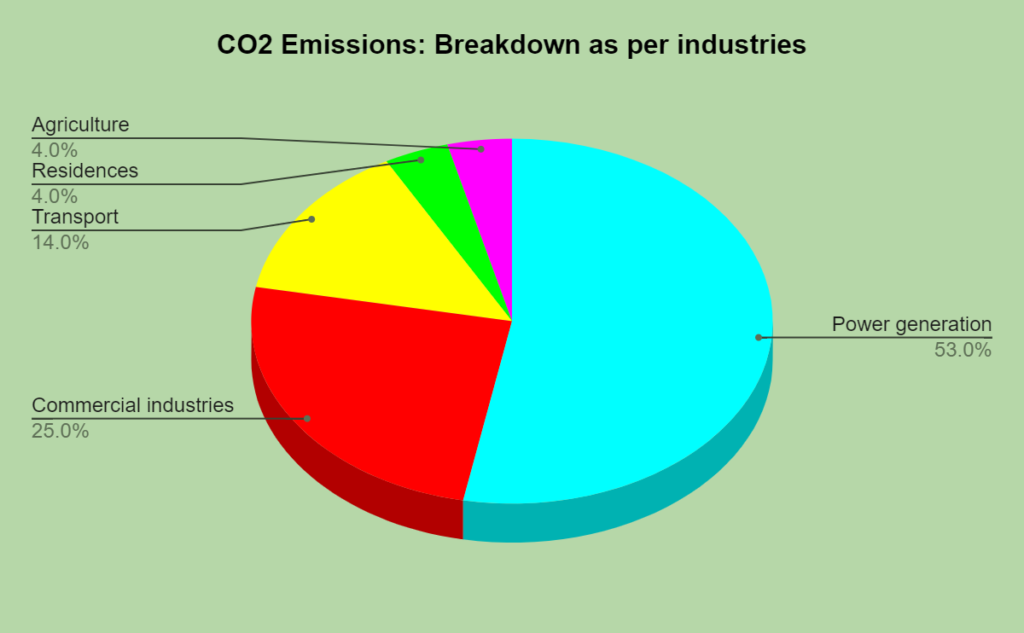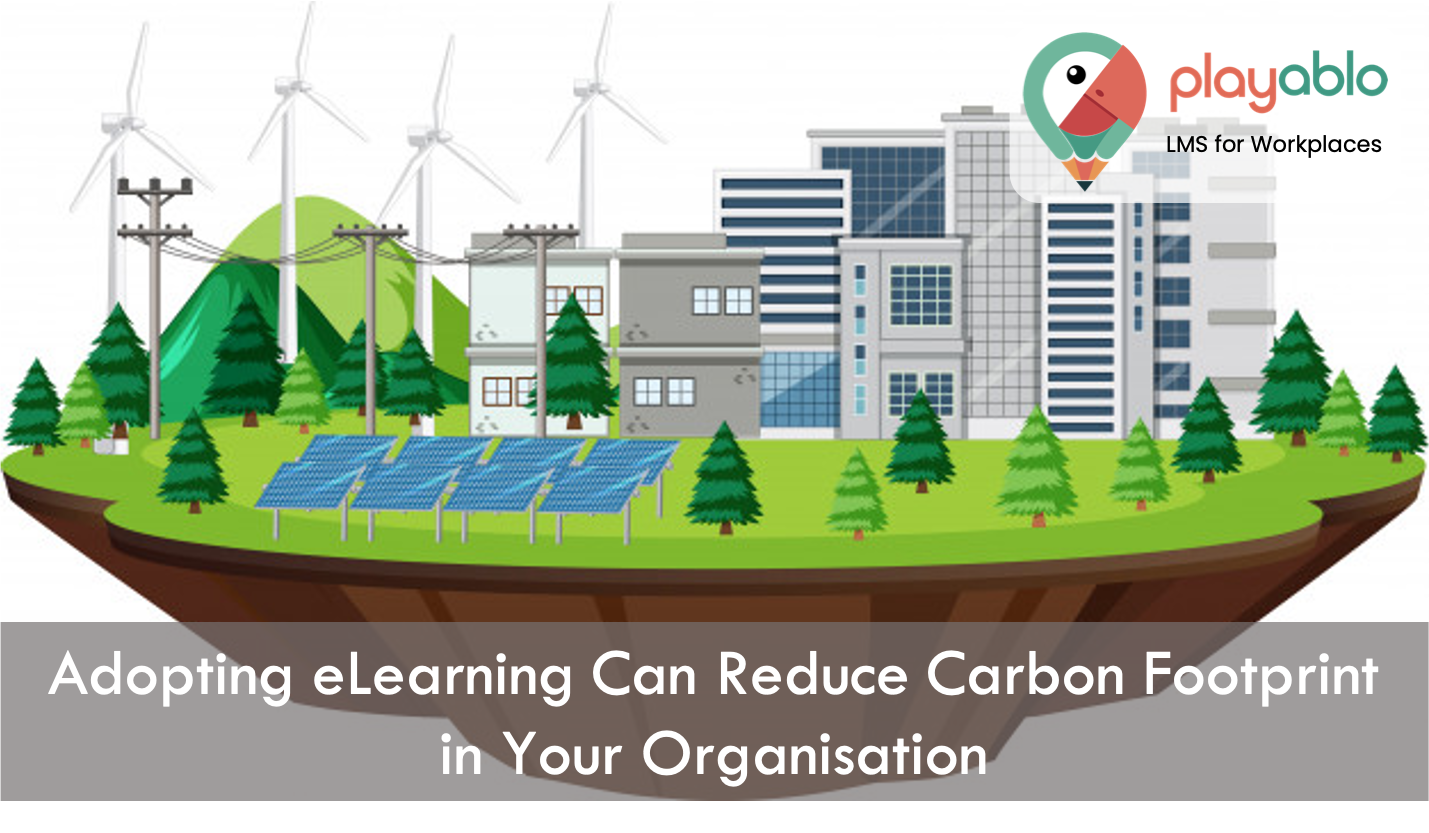Global warming is real. This ubiquitous and pervasive phenomenon negatively impacts the whole world via temperature surges and causes an accelerated rise in sea levels, resulting in increased coastal flooding. To add more to the downsides, it leads to a multiplication of wildfires and hurricanes. As you might already know, the primary cause of global warming is Carbon Dioxide (CO2) — a greenhouse gas that traps heat in our atmosphere. And corporates play a massive role in the increasing CO2 emissions. Therefore, it is high time that reducing carbon footprint becomes an integral part of the organisational initiatives. How? Let’s get started.
Table of Contents
How Can Organisations Focus on Reducing Carbon Footprint?
As per International Energy Agency (IEA) estimates, India’s total emissions from energy use are 2,251 MtCO2 (metric tons of carbon dioxide). The share of industrial sectors in the total emissions is segmented below:

Although there are several ways, companies can contribute toward reducing carbon footprint. But it is never enough. Yes, several organisations are indeed becoming environment-friendly and conscious of their impact on the environment. After all, we need to survive. And one of the most effective steps in this direction is digitally transforming corporate learning. This transition can have a substantial impact if our ultimate goal is to save the planet.
How eLearning Can Help in Reducing Carbon Footprint in Your Organisation?

1. Saying No to Paper
Did you know that “Each ream of paper used at an organisation releases more than 2 kilograms of CO2 into the environment? Each ream weighs around 2.5 kilograms on average, and globally we use around 300 million tons of paper each year” – Source. Hence, you can estimate the amount of carbon dioxide released each year in the atmosphere. But when you adopt eLearning, it eliminates the need for paper used in learning material like textbooks or quizzes, tests, syllabi, or assignment sheets. And saying no to paper goes a long way in reducing carbon footprint in your company.
2. Minimise the Need of Transportation
The conventional Instructor-Led Training is typically conducted in a classroom setting such as a seminar hall or auditorium. What does this entail? Each employee has to travel to that place to attend the sessions. So, it means using some form of transportation like cars, buses, or motorbikes, emitting CO2 in massive amounts. One-third of all greenhouse gas emissions in the world are from vehicles. When you transit to eLearning, you can deliver training directly to the employees on their smartphones, personal computers, laptops, or tablets. This model will help you minimise the need for transportation and reducing the carbon footprint in your organisation.
3. A Decrease in Consumption of Energy Resources

Massive seminar halls, auditoriums, or conference rooms inside an organisation, mainly for traditional learning, consume energy via computers, projectors, and smart boards, among others. Add to this the energy consumed by lighting and air conditioning, which are also harmful to the environment. All of these energy emissions result from the burning of fossil fuels, which releases millions of metric tons of carbon dioxide into the atmosphere.
eLearning can save energy, thereby reducing carbon footprint by eliminating the need for seminar halls, auditoriums, or conference rooms to train and develop employees. Moreover, online training can upskill and train a massive chunk of employees with minimal impact on total energy expenditure and consumed resources. After all, an eLearning class occupies virtually the same amount of server space for one student as it does for one hundred. What’s more? This strategy leads to substantial cost cuts as well!
Ad: PlayAblo’s Enterprise-Grade Micro-Learning platform is built for millennial learners. Micro-Learning, along with assessments and gamification features, ensures learning outcome measurement along with sustained engagement.
Find out more and request a custom demo!
The Big Picture

As you can already see, eLearning goes a long way to helping organisations significantly reducing carbon footprint overall. Research suggests that the effects of global warming caused by carbon dioxide emissions threaten the world in alarming ways. But scientists also agree that we all can do our part to reverse this trend by limiting our carbon footprints. And yes, eLearning is one of the easiest and practical solutions. National Wildlife Federation (NWF) calls eLearning “one of the most unexploited means of achieving a smaller carbon footprint.”
As cited by the NWF, “a joint study entitled Towards Sustainable Higher Education: Environmental impacts of campus-based and distance higher education systems is serving as a rallying cry among environmentalists.” The survey was carried out in 2007 by the Stockholm Environmental Institute (SEI) and the United Kingdom’s Open University Design Innovation Group (DIG) — taking into consideration 13 campus-based and seven online distance learning courses. And the results were surprising! Online learning:
- Consumed approximately 90% less energy than traditional campus university courses
- Produced approximately 85% fewer carbon dioxide emissions than traditional campus university courses.
However, even with eLearning, we do use many gadgets. Hence, we should be aware of the ways of how we can help in reducing carbon footprint via digitisation as well. Some of the measures include replacing old computers, technology, and appliances with more energy-efficient models. You can additionally coerce your employees to decrease their computer screen’s brightness level and ensure that it goes into sleep/ shut-down mode when not in use. Let’s explore this in more detail.
Gadget Optimisation

One of the significant downsides of using eLearning when reducing carbon footprint is the extra hours the instructor and their students spend on their individual computers. But research suggests that this added time consumes a mere fraction of the energy that an organisation typically consumes in its equipment, computers, and servers, used in offline training sessions.
You can go for more gadget optimisation by purchasing energy-saving devices. Replace old computers and digital equipment with newer, more energy-efficient models. Many modern gadgets, thanks to the constant march of modern technology, are consistently requiring less power. By upgrading your equipment, you aren’t only strengthening your capacity to work and play, but you are also lending a big hand to the environment.
Checking the Computer Settings
As per a study conducted by the National Energy Foundation (NEF), “your monitor consumes roughly two-thirds of the total energy that is required to power your computer.” When you ensure that your screen brightness is not too high, you save your eyes, pocketbook, and the environment. Another tip is to check your “sleep mode” setting to ensure that it kills power to your monitor in a timely fashion when your computer is not in active use.
Switching off Gadgets
This one is simple! When you switch off a gadget, it consumes zero power. But again, you might ask: does not booting up a computer take a lot of energy? Well, here is your answer. As per the same NEF study mentioned above, “as long as your computer remains off for just 16 minutes, it is more energy efficient to shut it down and restart it than to keep it running simply.”
Conclusion
Organisations have been increasingly embracing online learning for many reasons. When compared with the traditional classroom model, eLearning is not only more accessible and convenient, but it also leads to positive environmental impact benefits – fostering a healthier and sustainable planet.
Ad: PlayAblo’s Enterprise-Grade Micro-Learning platform is built for millennial learners. Micro-Learning, along with assessments and gamification features, ensures learning outcome measurement along with sustained engagement.
Find out more and request a custom demo!







Comments are closed, but trackbacks and pingbacks are open.